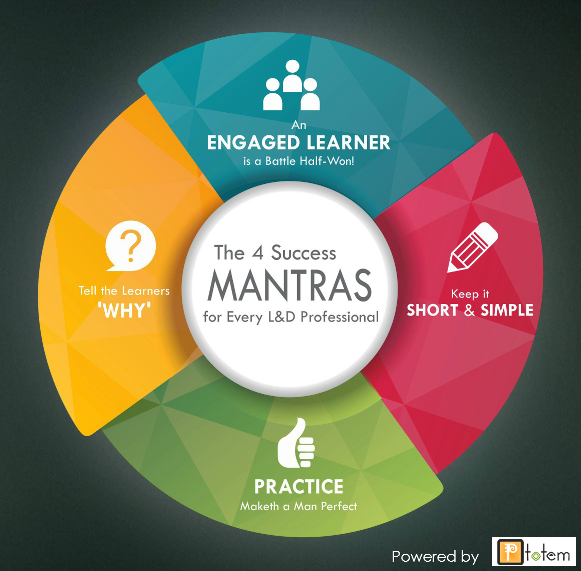 Note: Please feel free to use this infographic for personal or commercial purpose.
Note: Please feel free to use this infographic for personal or commercial purpose.
basics
7 E-learning Design Mistakes To Avoid
How To Be A Successful Instructional Designer
How People Learn …
When To Use Visuals in Learning Content
Using Case Studies To Make Your Elearning Course More Engaging
There is a big difference between a course that is engaging, and a course that is well-documented.
You may create a comprehensive course with interactive branch scenarios and detailed explanation, but, if it is not relevant to the learner, than it will just confuse or worst case, frustrate her. Such a pattern may be good and easy to build, but it is only good enough to share information. It lacks in creating engagement and results in poor retention in the mind of the learner. Such courses are ‘well-documented’, but not engaging.
Engagement requires an emotional connection between the content and the learner. It goes beyond presenting interactive content; it is about designing truly motivating learning experiences.
The biggest challenge in creating an elearning course is engaging the learner, and there is a very simple solution for this – Case Studies
So here’s how you can use case studies to make your course engaging and interesting.
- It is after all, a Story: Humans have used the art of story-telling as a mode of communicating ideas and knowledge since the Stone Age, and there is a reason behind it. We tend to remember a story better than just facts, and it provides a very practical, firsthand account of events that happened, and the appropriate solutions to them.
- It is Simple: The simpler your story, the clearer is the message and the easier it is for the learner to remember and use it when required. If you stuff your course with extra details, your course will end up being a clutter of abstract information, making it tougher for both – you and the learner.
- A Relevant Perspective: If you tell your story from the perspective of the customer, or anyone other than the learner, she will receive insights on the situation from a different perspective too. Also, this will raise the interest of the person enrolled in your course. Instead of telling the learner what they need to know, show them how not knowing affects others.
Even as a trainer, this makes things simpler for you as well.
Case studies need lesser time to build, and they rarely result in an information dump. Thus, you waste lesser time and energy, thinking and pondering over your course, and tweaking it time and again by introducing gimmicks to make it more engaging.
A case study is still mostly linear, but I see it as a first step in an iterative process of moving away from the boring click and read style. What is your take on this?
8 Reasons To Use Serious Games For Training
1. Highly Engaging
Serious games are very engaging and communicate in a fashion that is easily acceptable by the human mind. Use of elements like story, interesting characters, relevant settings, etc engage the user emotionally.
2. Safe Environment
Users learn to deal with real life-like situations in a safe and engaging environment. They can make mistakes and keep on practicing till they are well-trained, which in turn boosts their confidence.
3. Instructional Design Based
Serious games are always designed after conducting an instructional design study (the study of creating instructional experiences which make knowledge acquisition more efficient and effective). It foresees and tackles the possible roadblocks that might hinder the learning process.
4. Reusable & Cost-effective
Once designed, Serious Games can be used multiple times. You don’t need a facilitator or special sessions to use this. The cost for maintenance and updating a serious game is negligible given its extensive uses.
5. Easy to Understand
Serious games are great when it comes to delivering complicated knowledge. These games communicate complex pieces of information in a fun and engaging way.
6. Reporting & Analytics
Serious games allow you to capture the users’ data. This is one of the main advantages they have over offline or classroom training. These reports can be used later for optimising the training content.
7. Acts as a Booster
These games can boost any learning methodology i.e. These games provide a welcome break in between modules or learning schedules and engage the user by means of its gameplay.
8. Tried & Tested
Serious games ARE effective! Several Research Studies have acknowledged the fact that serious games do add on to the overall learning experience. These games have been used in different sectors like defense, retail, insurance, etc and have been found useful.
The 4 Success Mantras for Every L&D Professional
1. An engaged learner is a battle half-won!
No one likes to learn when he is bored. In fact, people get bored when the learning content is mundane. Make sure your learning content is not dull. Use different techniques like Case Studies, Serious Games, Videos, etc to engage your learners.
2. Practice maketh a man perfect
(Really? You want an explanation for this!)
A human brain is better equipped to process information when presented in small chunks. Divide your content accordingly for better consumption.
4. Tell the learners – ‘Why’
Give your learner a ‘reason’ to learn. Tell him how it will help him perform better or make his life better. It will motivate him to interact with the learning content.
A Day in the Life of a Serious Game Developer
If you are in the serious gaming industry, then probably, you would be familiar with this conversation.
(The conversation starts with me saying that I work with a serious gaming company)
The Other Guy: So, you develop games like Angry Birds? Which one have you developed?
Me (Exasperated already): No! We develop serious games. Not the fancy ones like Angry Birds or Candy Crush.
The Other Guy: Serious Games? What is it?
Me: These are games which are developed for purpose other than entertainment. These are games for training, research or marketing. In other words, these games are not just for fun, but for solving real world problems.
The Other Guy: Real world problems? Oh! Never heard about them. Seems like a new concept.
Me: Many think so, but it’s not. It’s been used since the 19th century, mostly for military or defence purpose. You know, Prussian forces used to have one called ‘Kriegsspiel‘. But the buzz around serious games began once the digital scenario started booming. The term ‘Serious Game‘ was coined in 2001 and then it was adopted increasingly by different industries.
The Other Guy: Whoa! I had no clue. By the way, do these games work? I mean, after all these are just games!
Me: Well, you are right! These are just games. Only, they have a serious purpose. Serious games use entertainment and engagement to convey serious and strategic information or achieve communication objectives.
The Other Guy: I am not sure I understand it.
Me: Alright! So tell me, why is a game fun?
The Other Guy: Because … it is a fun activity which you play and try to win.
Me: There you go, my friend! In any game, you play to win. You make decisions or plan moves in order to win. Serious games work in a similar fashion, except, it delivers some kind of learning using the same mechanism. Amusement is secondary here, and yet it is the secret ingredient that makes serious games work. That’s the reason why we use games to teach our kids. Don’t you think? It makes boring stuff interesting!
The Other Guy: You have a point! Can you name any of these games?
Me: Yes, there are many out there! There’s this puzzle game called ‘Foldit’ which explains how protein folding happens in a human body. Even games like ‘Need for Speed’ can be termed as ‘Serious Games’ …
The Other Guy (Not letting me complete my sentence): Need for Speed? What does one learn from it? I have been playing that one for years!
Me (Now Frustrated): While playing the game, have you noticed advertisements for Porsche or any other racing cars?
The Other Guy: Yes! They’re always there!
Me: That’s the purpose. Need for Speed is an Advergame, a version of serious games, that is used for advertising brands. There are many out there! Even Movies come up with games for promotional purpose. Iron Man has done it. The Harry Potter game was a rage when it was released few years back.
The Other Guy: I remember that one!
This is how it starts and continues … But in most cases, at this point, either I am bored to continue or the other guy is!
So, have you ever had a conversation like this?
7 Tips to Integrate Games into Your eLearning Course
Everyone loves to play! What if I tell you, that you can use games to teach complicated subjects like Compliance Training or processes like Account opening? Yes, these games for training or serious games, do create an engaging learning experience.
Let’s find out how you can integrate these serious games into your elearning courses.
1. Set learning objectives
Yes! Games are for fun! But everyone plays to win! Set your learning objectives beforehand to make sure your game stays in tune with the content.
2. Communicate desired outcomes
Inform the learners what they will gain from playing this game. This will motivate them to participate actively in it.
3. Tell little, engage more
Do not give out all the details. Communicate what is required. Don’t reveal all the suspense. This will keep the learners engaged as well as won’t take out all the fun!
4. Create opportunity for application
eLearning allows one to learn in a safe environment. Create situations such that learned concepts can be applied. This will help in retention and create a favourable learning experience.
5. Keep it real and relevant
Keep all the descriptions and details like measurements, tools, techniques, spaces, etc., accurate. Virtual practice reduces room for real life mistakes.
6. Value content over gaming
Games make eLearning very interesting, no doubt there! And yet, if they distract your learner from the learning content, then it will fail your learning initiatives.
7. Get regular feedback
Feedback is the best way to know how well the game or module is. A quick quiz works best!








